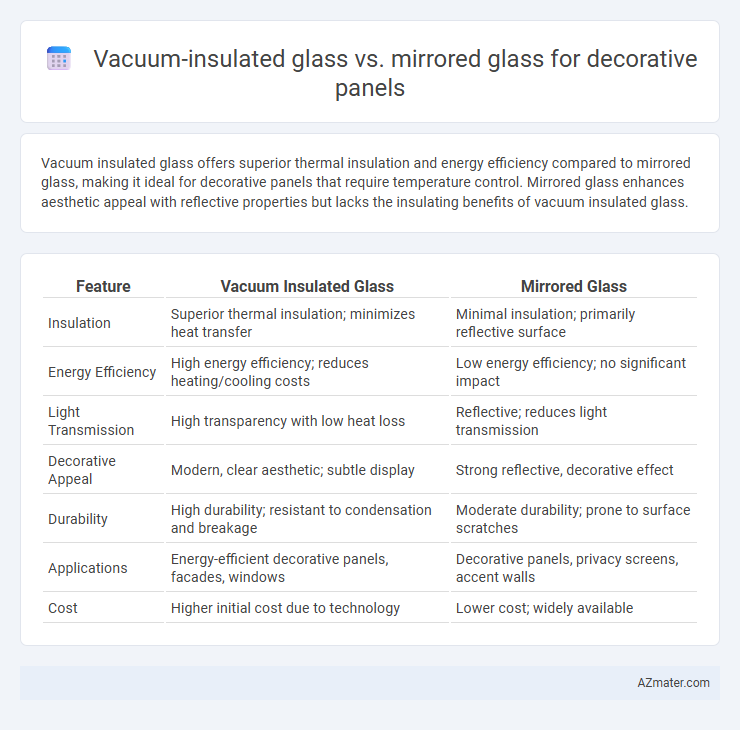Vacuum insulated glass offers superior thermal insulation and energy efficiency compared to mirrored glass, making it ideal for decorative panels that require temperature control. Mirrored glass enhances aesthetic appeal with reflective properties but lacks the insulating benefits of vacuum insulated glass.
Table of Comparison
| Feature | Vacuum Insulated Glass | Mirrored Glass |
|---|---|---|
| Insulation | Superior thermal insulation; minimizes heat transfer | Minimal insulation; primarily reflective surface |
| Energy Efficiency | High energy efficiency; reduces heating/cooling costs | Low energy efficiency; no significant impact |
| Light Transmission | High transparency with low heat loss | Reflective; reduces light transmission |
| Decorative Appeal | Modern, clear aesthetic; subtle display | Strong reflective, decorative effect |
| Durability | High durability; resistant to condensation and breakage | Moderate durability; prone to surface scratches |
| Applications | Energy-efficient decorative panels, facades, windows | Decorative panels, privacy screens, accent walls |
| Cost | Higher initial cost due to technology | Lower cost; widely available |
Introduction to Decorative Glass Panels
Decorative glass panels enhance interior design by offering aesthetic appeal and functional benefits through materials like vacuum insulated glass and mirrored glass. Vacuum insulated glass provides superior thermal insulation and energy efficiency, reducing heat transfer while maintaining transparency and clarity. Mirrored glass adds depth and brightness to spaces, reflecting light to create a visually expansive environment, often used for stylistic impact in decorative panel applications.
What is Vacuum Insulated Glass?
Vacuum insulated glass (VIG) consists of two or more glass panes separated by a vacuum layer, providing superior thermal insulation by minimizing heat transfer. Its slim profile and high energy efficiency make it ideal for decorative panels in architectural applications where both aesthetics and temperature control are essential. Unlike mirrored glass, which primarily offers reflective properties and visual appeal, vacuum insulated glass enhances insulation without compromising natural light transmission.
What is Mirrored Glass?
Mirrored glass is a type of glass coated with a reflective metallic layer that creates a mirror-like surface, ideal for decorative panels due to its ability to enhance light and create visual depth. Unlike vacuum insulated glass, which focuses on thermal insulation and energy efficiency, mirrored glass primarily serves aesthetic purposes while providing privacy and enhancing interior design. Its versatility allows it to be used in various applications, including wall panels, furniture, and architectural features, making it a popular choice for modern decorative solutions.
Thermal Performance Comparison
Vacuum insulated glass (VIG) offers superior thermal performance compared to mirrored glass due to its near-complete elimination of conductive and convective heat transfer, resulting in significantly lower U-values and enhanced energy efficiency for decorative panels. VIG typically achieves U-values as low as 0.5 W/m2K, whereas mirrored glass panels generally have U-values around 2.7 W/m2K, indicating higher heat loss. This thermal efficiency makes vacuum insulated glass ideal for environments requiring stringent temperature control and reduced energy consumption in decorative applications.
Aesthetic Appeal and Design Versatility
Vacuum insulated glass enhances decorative panels with a sleek, transparent look while providing excellent thermal insulation, allowing designers to maintain clarity without compromising energy efficiency. Mirrored glass offers a striking reflective surface that adds depth and a modern aesthetic, ideal for creating focal points and enhancing light distribution in interior spaces. Both materials deliver distinct visual effects, with vacuum insulated glass favoring minimalist elegance and mirrored glass emphasizing bold, dynamic design versatility.
Energy Efficiency Considerations
Vacuum insulated glass offers superior thermal insulation by minimizing heat transfer, resulting in enhanced energy efficiency compared to mirrored glass, which primarily reflects sunlight but lacks significant insulating properties. Incorporating vacuum insulated glass in decorative panels reduces heating and cooling demands, lowering energy consumption and utility costs in buildings. Mirrored glass may contribute to glare control and solar heat gain reduction but does not provide the same level of energy savings as vacuum insulated glass technology.
Durability and Maintenance Requirements
Vacuum insulated glass offers superior durability due to its resistance to thermal stress and condensation, significantly reducing the risk of fogging and seal failure over time. Mirrored glass, while aesthetically appealing, generally requires more frequent maintenance to prevent tarnishing, scratches, and discoloration from environmental exposure. The low-maintenance nature of vacuum insulated glass makes it a more durable choice for decorative panels in high-use or variable climate settings.
Cost Analysis: Vacuum Insulated vs. Mirrored Glass
Vacuum insulated glass typically costs 30-50% more than mirrored glass due to advanced manufacturing processes and superior thermal insulation properties. Mirrored glass offers a lower upfront expense but lacks the energy efficiency benefits that reduce long-term heating and cooling costs. Investing in vacuum insulated glass can lead to significant energy savings, offsetting the initial price difference over the lifespan of decorative panels.
Best Applications for Decorative Panels
Vacuum insulated glass offers superior thermal insulation and soundproofing, making it ideal for decorative panels in energy-efficient buildings and quiet environments such as offices and luxury homes. Mirrored glass enhances aesthetic appeal and reflects light, perfect for decorative panels in retail spaces, interior walls, and showrooms where visual impact and brightness are priorities. Choosing between vacuum insulated glass and mirrored glass depends on whether the primary goal is functionality like insulation or aesthetic enhancement in decorative panel applications.
Choosing the Right Glass for Your Project
Vacuum insulated glass offers superior thermal insulation and energy efficiency, making it ideal for decorative panels in climates requiring temperature control. Mirrored glass enhances aesthetic appeal by reflecting light and creating visual depth, suitable for interior design and artistic applications where style is prioritized. Selecting the right glass depends on balancing energy performance needs with decorative goals to optimize functionality and appearance in your project.

Infographic: Vacuum insulated glass vs Mirrored glass for Decorative panel
 azmater.com
azmater.com